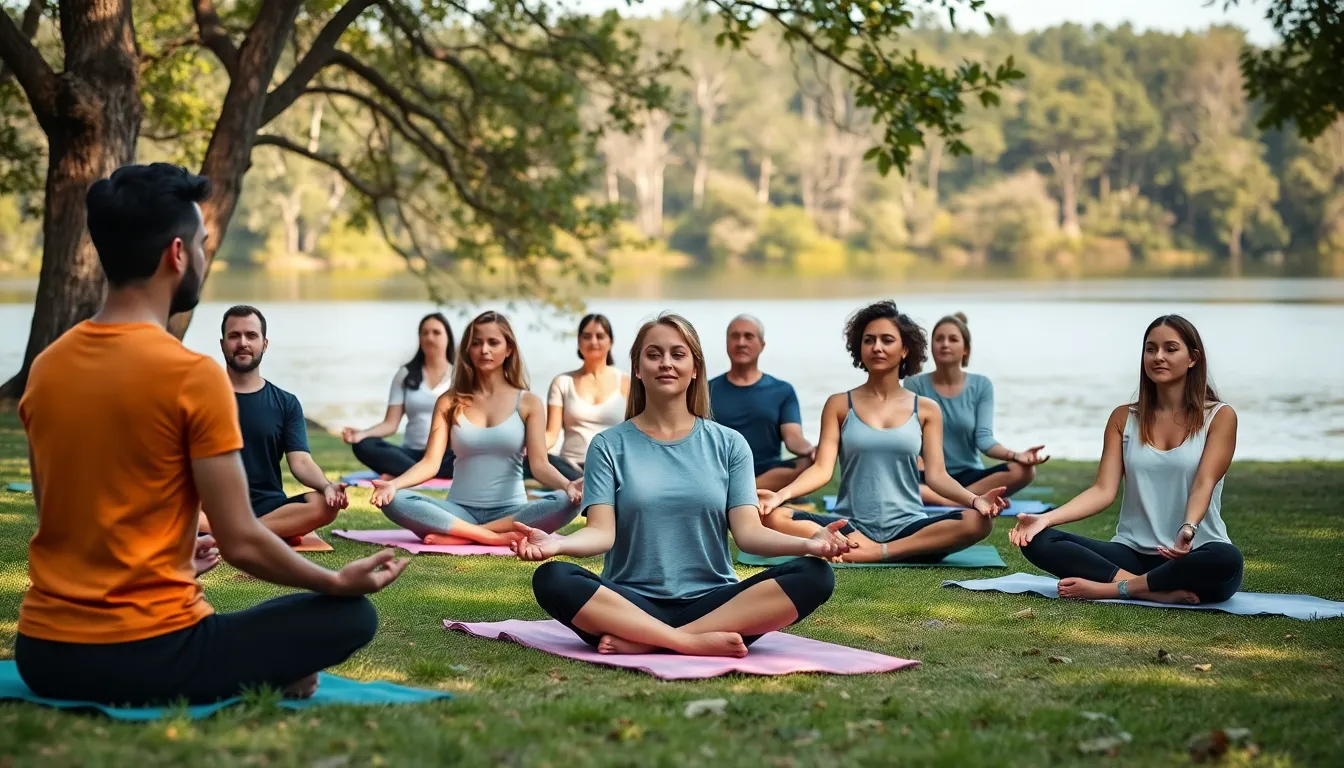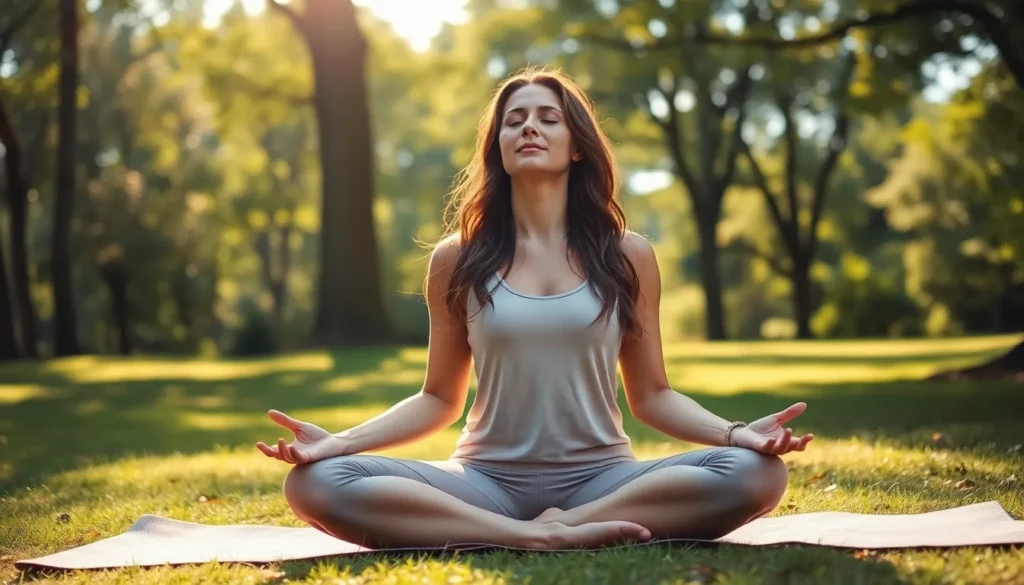In a world buzzing with distractions, finding your zen can feel like searching for a needle in a haystack. But fear not! Mindfulness practices are here to rescue you from the chaos, like a superhero swooping in to save the day. Whether it’s a quick meditation or a mindful walk, these techniques can transform your day from frantic to fabulous.
Imagine sipping your morning coffee while actually tasting it instead of scrolling through your phone. Sounds dreamy, right? Mindfulness isn’t just for yogis in flowing robes; it’s for everyone who wants to embrace the present moment and kick stress to the curb. Dive into these practical examples of mindfulness practices and discover how easy it is to sprinkle a little calm into your everyday life.
Table of Contents
ToggleOverview of Mindfulness Practices
Mindfulness practices encompass a variety of techniques aimed at enhancing present-moment awareness. Meditation serves as a foundational practice, allowing individuals to focus their minds and breathe deeply. Practicing mindful breathing can improve concentration and reduce anxiety.
Mindful eating encourages individuals to engage fully with their food. Savoring each bite fosters appreciation and can prevent overeating. Guided meditation involves listening to recorded instructions, making it accessible for beginners looking to cultivate mindfulness.
Mindful movement incorporates activities such as yoga and tai chi. These practices promote awareness of bodily sensations and alignment. Walking meditation invites participants to focus on each step, integrating movement with mindfulness.
Gratitude journaling cultivates an appreciation for daily experiences. Writing down three things one is thankful for can shift perspectives. Body scan meditation focuses on bodily sensations, fostering relaxation and reducing stress.
Mindfulness apps and online resources support practice. Many people use these tools to establish and maintain their routines. Schools and workplaces increasingly integrate mindfulness programs, enhancing overall well-being and productivity.
Daily mindfulness practices form the foundation for long-term benefits. Engaging in short periods of mindfulness can significantly improve mental health. Consistency in practice leads to greater awareness and a more fulfilling life.
Benefits of Mindfulness Practices

Mindfulness practices offer substantial benefits for both mental and physical health, enhancing well-being and quality of life.
Mental Health Benefits
Engagement in mindfulness practices contributes to reduced symptoms of anxiety and depression. Research shows that regular meditation strengthens emotional regulation and increases positive mood. Mental clarity improves through enhanced focus, leading to better decision-making abilities. Mindful breathing techniques also promote relaxation responses, helping to alleviate stress. Cultivating a non-judgmental awareness fosters self-acceptance and compassion, which can improve self-esteem. Practicing gratitude reinforces positive thinking and shifts focus from negativity to appreciation.
Physical Health Benefits
Mindfulness practices positively influence physical health by encouraging a reduction in stress-related ailments. Research indicates that consistent meditation lowers blood pressure and improves cardiovascular health. Mindful eating habits promote healthier dietary choices, reducing the risk of obesity and related conditions. Additionally, regular mindful movement activities, such as yoga, enhance flexibility and overall physical fitness. Increases in immune function have been observed in those practicing mindfulness, showcasing its benefits in maintaining overall wellness. Improved sleep quality often results from reduced stress levels, leading to better daytime energy and productivity.
Mindfulness Practices Examples
Mindfulness practices foster present-moment awareness. Various techniques provide unique pathways to enhance mental and physical well-being.
Meditation Techniques
Meditation encompasses techniques like focused attention and loving-kindness. Practitioners maintain attention on a specific object or thought. Starting with just five minutes daily benefits beginners. Using guided sessions via apps often helps individuals stay on track. Progressing to longer sessions builds deeper focus and self-awareness.
Breathing Exercises
Breathing exercises cultivate relaxation through intentional focus on the breath. Simple techniques such as the 4-7-8 method enhance calmness: inhale for 4 seconds, hold for 7, and exhale for 8. Engaging in these practices daily leads to reduced stress. It’s possible to practice anywhere, making it accessible for everyone. Practitioners report improved concentration and emotional regulation.
Body Scan Practices
Body scan practices promote awareness of physical sensations throughout the body. Lying comfortably, individuals systematically focus on each part, observing tension and relaxation. This practice fosters deep relaxation and helps identify stress areas. Performing a body scan for just 10 minutes enhances overall awareness. Regular practice contributes to improved body image and self-connection.
Mindful Movement
Mindful movement includes activities like yoga and tai chi. Participants engage in gentle, flowing motions, emphasizing breath and awareness. Each movement invites a deeper connection to the body’s sensations. Practicing mindful movement improves flexibility and balance. Joining group classes can also create a sense of community and shared experience.
Journaling and Reflection
Journaling and reflection allow individuals to explore thoughts and emotions through writing. Setting aside time daily to jot down feelings enhances self-awareness. Gratitude journaling, where individuals write down three things they’re thankful for, shifts focus to positive experiences. Reflection fosters clarity and personal growth. Maintaining a consistent journaling habit leads to lasting benefits in emotional well-being.
Integrating Mindfulness into Daily Life
Integrating mindfulness into daily routines fosters presence and reduces stress. Practicing mindful breathing during daily activities, such as waiting in line or commuting, enhances focus and tranquility. Engaging fully with food during meals promotes appreciation and mitigates overeating.
Mindful walking offers an effective way to connect with surroundings. While walking, individuals can pay attention to each step, the sensation of the ground beneath their feet, and the rhythm of their breath. This practice encourages being present rather than lost in thought.
Using a gratitude journal can also cultivate mindfulness throughout the day. Writing down three things to appreciate each day shifts focus toward positivity and fulfillment. This simple exercise nurtures a sense of awareness regarding daily experiences and connections.
Incorporating formal meditation sessions, even for just five minutes, provides a necessary mental reset. Focused attention, whether on breath or sounds, can reduce anxiety and foster clarity. Loving-kindness meditation encourages compassion, enhancing interpersonal relationships.
Mindfulness apps serve as valuable resources for those new to these practices. Various programs guide users through meditation techniques, breathing exercises, and mindful movements. Many individuals find community support in these digital platforms, enhancing commitment.
Mindful movement practices, such as yoga or tai chi, can also be part of daily routines. These activities enhance physical health, improve flexibility, and foster mental clarity. Each practice supports emotional well-being and contributes to a more balanced lifestyle.
Daily integration of mindfulness practices leads to diminished stress and improved overall fulfillment. Embracing simple, accessible techniques enables everyone to cultivate a mindful approach to life.
Mindfulness practices offer a powerful way to navigate the chaos of everyday life. By incorporating simple techniques like mindful breathing and gratitude journaling, individuals can enhance their mental and physical well-being. These practices foster a deeper connection to the present moment and promote a sense of calm and clarity.
As more people discover the benefits of mindfulness, integrating these techniques into daily routines becomes increasingly essential. Whether through meditation, mindful movement, or simply savoring a meal, there’s a path for everyone. Embracing mindfulness can lead to a more fulfilling and balanced life, making it a worthwhile pursuit for anyone seeking peace amid distractions.





